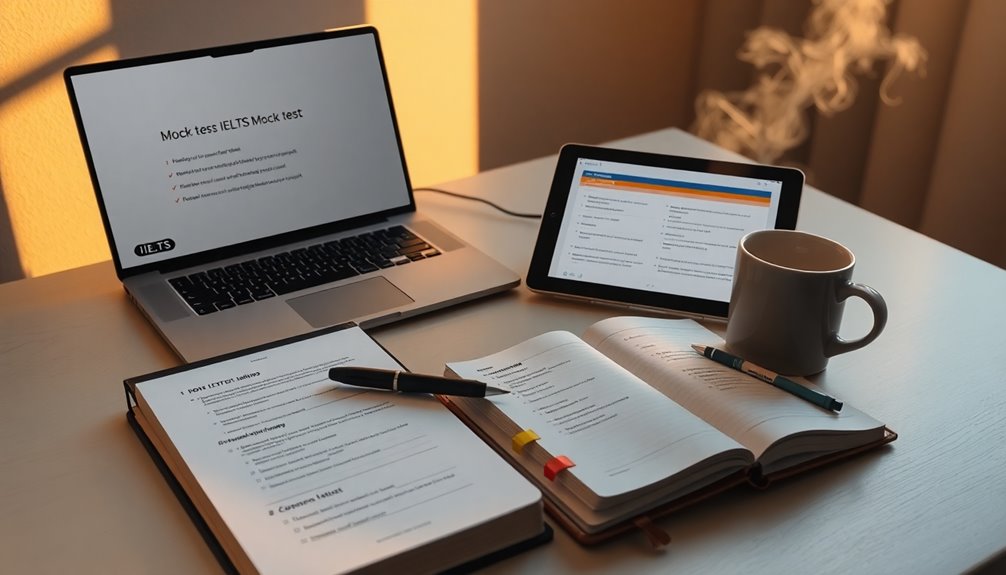
You’ll start by mapping your current band with a timed mock test, spotting recurring errors and setting clear mini-goals. Build a short, daily schedule that targets weak skills while training section timing. Use focused Listening drills, scanning strategies for Reading, and clear planning for Writing to boost coherence. Record and review Speaking practice, and track progress with error logs and smart tools or a tutor. Keep going and you’ll uncover practical steps to raise your band.
Highlights
- Map your current band with a timed mock test, log errors, and set incremental, deadline-driven band targets.
- Build a personalized weekly study plan with short focused sessions prioritizing weakest skills and regular checkpoints.
- Master section timing by practicing task-specific pacing, scanning techniques, and simulated exam conditions with timers.
- Use targeted Listening/Reading drills, varied audio accents, concise note-taking, and error-analysis to eliminate recurring mistakes.
- Improve Writing and Speaking via planned responses, recorded practice, tutor feedback, and peer review in study communities.
Mapping Your Current Band and Setting Real Targets
Before you design a study plan, you need a realistic snapshot of where you are now: take a full, timed practice test under exam conditions, score each section against IELTS band descriptors, and note the specific task-level mistakes that cost you points. You’ll use self assessment methods to map strengths and weak spots objectively, logging recurring errors and timing issues. Then apply target setting strategies: set incremental band goals per skill, deadlines, and measurable milestones that preserve your autonomy. Stay flexible — revise targets after periodic retests — so your roadmap to freedom remains realistic, motivating, and fully evidence-based.
Building a Personalized Study Schedule That Sticks
Now that you’ve mapped your current band and set realistic targets, you need a study schedule that fits your life and forces steady progress. Design short, focused sessions tied to clear micro-goals so you keep momentum and study motivation. Prioritize weak areas but mix skills to stay engaged; build routines around your peak energy, not rigid blocks that trap you. Allow built-in review and weekly checkpoints for progress checks and flexible adjustments when life shifts. Treat the plan as a living tool: tweak frequency, intensity, or resources, preserve freedom, and commit to consistency that produces measurable improvement.
Mastering Time Management for Each Section
Now you’ll set clear time allocations for each section so you know how many minutes to spend on Reading, Listening, Writing and Speaking. Break those allocations into task-specific pacing—like how long for skimming passages, planning an essay, or answering cue-card prompts—and adjust them to match your strengths. Then practice with timers in realistic conditions until those rhythms become automatic.
Section-Wise Time Allocation
Because each IELTS paper demands different skills and pacing, you’ll perform best when you assign strict time blocks to Listening, Reading, Writing and Speaking and stick to them in practice and on test day. Plan section timing precisely: allocate minutes per task, mark checkpoints, and practice finishing slightly early. Use strategic breaks during study sessions to reset focus and reduce fatigue. For Listening and Reading, train scanning and prediction; for Writing, divide brainstorming, drafting, and editing; for Speaking, rehearse concise responses. Treat timing as freedom: clear limits let you trust instincts, avoid panic, and deliver controlled, confident performance on exam day.
Task-Specific Pacing
When you break each IELTS section down into its component tasks and assign strict micro-deadlines, you stop guessing and start executing with purpose; this chapter shows how to map task-by-task timing so you finish every task with time to spare. You’ll use task analysis to identify routines: question types, expected responses, and checkpoints. Then set pacing strategies per task—what’s bold, what’s quick, what needs review. You’ll create a flexible template you can carry into the exam, freeing mental energy for clarity and style. This method keeps you calm, efficient, and in control without rigidly sacrificing adaptability.
Practice With Timers
If you want to turn your pacing plans into reliable performance, practice with timers as if the clock were part of the exam room—strict, visible, and nonnegotiable. You’ll structure timed drills for each section, simulating listening, reading, writing, and speaking under pressure. Use progressive timer challenges: shorter intervals for tricky tasks, full-length runs for stamina. Track results, adjust strategies, and isolate weak spots without losing freedom to choose techniques that suit you. Consistent timed practice builds automatic pacing, reduces anxiety, and gives you control on test day. Treat the timer as a coach, not a jailer, and you’ll own your time.
High-Yield Practice Techniques for Listening Accuracy
Anyone can sharpen their IELTS listening score by focusing on a few targeted, high-yield practices that build accuracy under real test conditions. You’ll use listening drills and varied audio resources to mimic exam pacing; do comprehension exercises immediately after each clip. Practice concise note taking techniques so you capture keywords, not whole sentences. Expose yourself to accent variations and simulate café or transit noise for distraction management. Schedule regular feedback sessions to correct recurring errors, then design targeted practice around those weaknesses. Stay disciplined, track progress, and choose exercises that free you to improve efficiently and confidently.
Writing Strategies to Boost Coherence and Band Scores
Although strong grammar and rich vocabulary matter, your band will rise most when your ideas flow logically and your paragraphs link clearly, because coherence lets examiners follow and reward your argument. Use clear topic sentences, tight paragraph structure and linking phrases to guide readers. Plan briefly: outline main point, support, example, mini-conclusion. Vary cohesive devices—but don’t overuse them—so connections feel natural. Practice editing for logical progression and remove off-topic sentences. Time your response to leave editing minutes. These coherence techniques directly target band score提升 by making your argument readable, persuasive and confidently structured, giving you freedom to express ideas precisely.
Speaking Preparation: Fluency, Pronunciation, and Confidence

When you practice speaking, focus first on fluency and natural rhythm so your ideas come out smoothly rather than in halting fragments; that means rehearsing common topics, using short planning time to map a quick structure, and speaking aloud daily to build automaticity. You’ll use targeted speaking exercises and conversational practice to widen confidence and freedom. Combine role playing scenarios with vocabulary expansion and accent reduction drills. Record yourself, apply self recording techniques, review weaknesses, and invite peer feedback to sharpen delivery. Use interactive speaking apps for varied prompts and timed responses, then iterate until speech feels natural and under your control.
Reading Approaches for Faster Comprehension and Accuracy
When you approach a reading passage, skim first to catch the title, topic sentences, and any keywords so you know the text’s skeleton before you read in detail. Then use the questions to guide your scanning—hunt only for the information you need and ignore distracting details. These two tactics together speed comprehension and boost accuracy under exam time pressure.
Skimming for Key Ideas
You are trained on data up to October 2023. You’ll skim to capture big-picture meaning fast, boosting reading efficiency and freeing time for tougher questions. Start by scanning titles, first sentences, and topic sentences to map the passage. Look for signal words, repeated concepts, and paragraph shifts to aid key idea identification. Don’t read every detail — note where evidence or examples live so you can return if needed. Practice timed skimming to build speed without losing accuracy. This strategic habit gives you control: you’ll move through sections confidently, allocate effort smartly, and protect exam momentum.
Question-Driven Reading
How do you turn questions into a roadmap for every passage? You scan question types first—matching, true/false/not given, multiple choice—so you know what to hunt. You set intent: locate names, dates, opinions, or synonyms. As you read, you tick off answers, using reading strategies like locating topic sentences, skimming for anchors, and scanning for keywords. Don’t read every line; let questions guide where you slow down. This keeps you focused, faster, and more accurate. With practice you’ll control time and stress, freeing yourself to target answers confidently and move through sections with calm precision.
Using Mock Tests and Error Logs to Drive Improvement

Although mock tests are only simulations, they’re the most reliable mirror of your current IELTS readiness: paired with a disciplined error log, they show not just what mistakes you make but the patterns behind them, so you can target weak skills, refine timing, and track real progress. You’ll use mock test analysis to identify recurring traps—time sinks, grammar slips, or task-misunderstanding—and record them in an error log review. Then you’ll set focused drills, adjust strategies, and repeat concise tests to confirm gains. This cycle keeps you efficient, autonomous, and steadily closer to the score that reveals your next chapter.
Leveraging Online Tools, Tutors, and Community Support
When you combine smart online tools, targeted tutor guidance, and an active study community, your IELTS preparation becomes faster, more focused, and less isolating. You’ll use curated online resources to target weak areas, track progress, and practice realistic tasks. Be strategic in tutor selection: pick specialists who push you, give actionable feedback, and fit your schedule. Community engagement keeps motivation high; join study groups, exchange feedback, and simulate speaking tests. Build support networks that free you from isolation while preserving autonomy—set boundaries, share goals, and rotate roles. This mix helps you improve efficiently and confidently, on your own terms.
Some Questions Answered
How Do I Handle Test-Day Anxiety Beyond Practice Routines?
On test day, you calm nerves with focused test day techniques and clear mental strategies: breathe deeply, visualize success, and follow a simple checklist so you’re not scrambling. Use grounding exercises between sections, pace yourself, and reframe anxiety as energy you can direct. Trust your prep, take short breaks when allowed, and have a backup plan for glitches. These steps give you freedom to perform under pressure.
Can I Improve Bands Without Daily Study Hours?
Yes — you can improve bands without daily hours. You’ll use effective study techniques: focused, high-impact sessions, targeted error analysis, and graded practice. Pair that with productive time management — short, scheduled blocks, prioritizing weak skills and simulating test conditions. You’ll track progress, reuse mistakes as lessons, and rest deliberately. This lets you gain freedom from grind while steadily boosting band scores through smart, strategic effort rather than constant study.
Which Accents Should I Prioritize for Listening Practice?
Prioritize British and American accents first, since they appear most in IELTS materials, then add Australian and Canadian to broaden understanding. You’ll get strategic gains by focusing on common pronunciation, linking, and rhythm in British and American speech, then tackling vowel shifts and faster speech in Australian and Canadian accents. This approach gives you freedom to adapt during the test and boosts confidence listening to varied speakers without overloading your study time.
Are AI Essay Graders Reliable for Final Assessments?
AI essay graders can’t be fully relied on for final assessments. You’ll find AI reliability varies: grading accuracy can be good for surface features but misses nuance. Expect uneven performance consistency across prompts and styles, and watch for bias concerns that disadvantage certain voices. Use AI as a strategic, efficient second opinion—speeding drafts and spotting patterns—but pair it with human review to protect fairness, depth, and the freedom to express complex ideas.
How Do I Maintain Motivation During Long Study Plateaus?
Steady, stubborn steps sustain you. You keep motivation by revisiting clear goal setting, breaking big aims into bite-sized benchmarks, and scheduling regular study breaks to recharge. Track tiny triumphs to prove progress, vary tasks to prevent plateau paralysis, and lean on allies or accountability systems. Celebrate small successes, adjust strategies when stalling, and remember your desire for freedom — study smart so you reclaim time and keep momentum moving forward.
Summing Everything Up
You’ve mapped where you are and set real targets, so now keep to your plan and tweak as you go — slow and steady wins the race. Use focused practice, timed mocks, and error logs to expose weak spots; then attack them with targeted drills, online tools, and tutor feedback. Stay consistent with speaking practice and timed writing, and lean on community support when you stall. With strategy and persistence, you’ll reach your online IELTS goals.
